I first posted this piece on 13 Jan 2024 but soon realized that I had not dug deep enough. So this is the original post, plus the additional research.

Tuesday was a good day. It was a day when I had confirmation that my writing was reaching people, informing them, and encouraging questions.
Carol from the Stoneware Museum of Monmouth contacted me asking what I might know about the relationship between Hubert Fassbender and the Western Stoneware Pottery company. The Museum is dedicated to preserving the past of the Monmouth, Illinois community and sharing knowledge of stoneware. (Visit them at their website https://monmouthstonewaremuseum.com/ )
What DID I know? Well, Kaukauna Klub cheese has always been packed in crocks. Not the answer she was looking for. I knew I could collect bits and pieces from my research, but what did I know, and what was I missing? Challenge accepted. I created a timeline with accompanying documents, but I now feel compelled to flesh out the facts and take another look.
Kaukauna Klub Cheese is a spreadable natural cheese product, and as Hubert Fassbender, “the originator,” would say, “It is not processed cheese.” I believe it is a variation of the product that he first produced in 1915 for the Anona Cheese Co. in Appleton, Wisconsin. When Anona dissolved in 1931, selling its assets to the Borden company, I believe that Hubert began tinkering with the recipes he had produced many years ago. However, there is also the thought that he never STOPPED tinkering with the product. This idea is supported by comments that state: “Called Kaukauna Klub cheese, it represents the results of 15 years of experiments and development of special equipment.”1 1933 minus 15 equals 1918, which is the year that Hubert started the South Kaukauna Dairy Company and one year after Anona moved their production facility to Chicago, Illinois.
Company lore states that in the winter of 1933, “the lowest point of the depression,” Hubert mixed a small batch of cheese in a mixing bowl in the office of South Kaukauna Dairy. ‘He called in the help and asked people to taste it.’ Everyone liked it. Taking it home, ‘the folks at home liked it too.’2
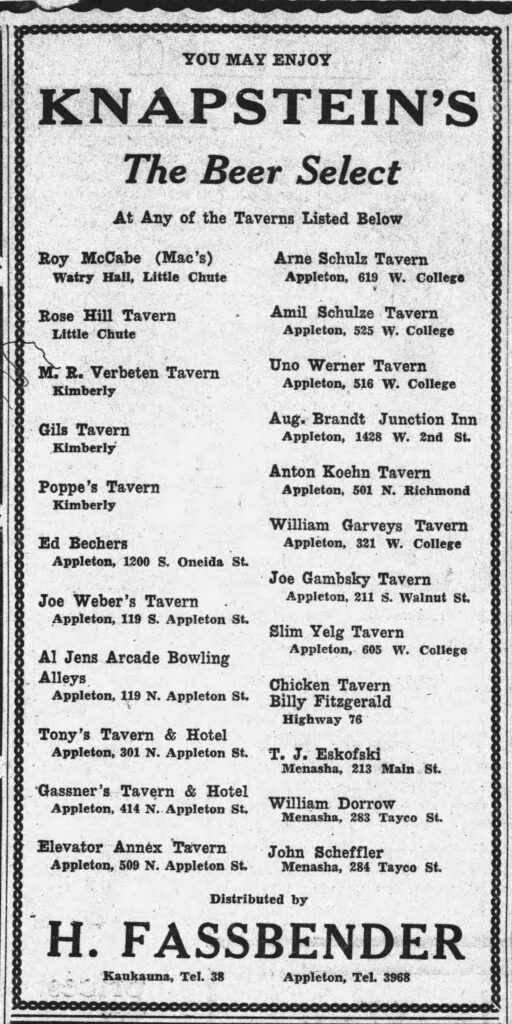
1918 to 1933. It was in 1918 that Congress passed the 18th Amendment to the Constitution prohibiting the manufacture, transportation and sale of alcoholic beverages, passing into law 17 Jan 1920. But now, at the end of 1933 (5 Dec 1933), Prohibition was ending, and Americans could once again legally sell and consume alcohol. A means of distribution was needed.
South Kaukauna Dairy had the refrigeration equipment needed, and so Hubert added a beer depot to his list of offerings, proudly distributing at least two products, Gettelman’s, a Milwaukee beer produced by the A. Gettelman Brewing Co.3 and Knapstein’s, produced by the Knapstein Brewing Company of New London, a beer “more perfect in every way than you’ve ever tasted. It’s the result of a great combination — Purity, Skill, and Proper Aging.”4
In a letter circa 1935, Hubert stated: “KAUKAUNA KLUB was perfected about the time when beer returned with the only object in mind for local taverns. The originator [Hubert] had not thought of nation wide distribution.” “The Conway Hotel in Appleton, Wisc. was the first account. They served it on their bar [as part of what was called their “free lunch]. Traveling men began to buy it and carried it home with them. They in turn showed it to their friends. It soon happened that they began to form clubs of six and sent to the plant for it to be shipped them. From there it spread all over the United States.”5
One of the drivers for this beer distribution route was Hubert’s nephew Arthur Ellenbecker, whom I interviewed when he was 98 years old, and he well remembered the excitement of the club cheese. He was also quick to state that these routes were not his favorite, as with each delivery, he was expected to sit down and enjoy a glass of beer. This not only delayed his deliveries but was too many beers throughout the day.
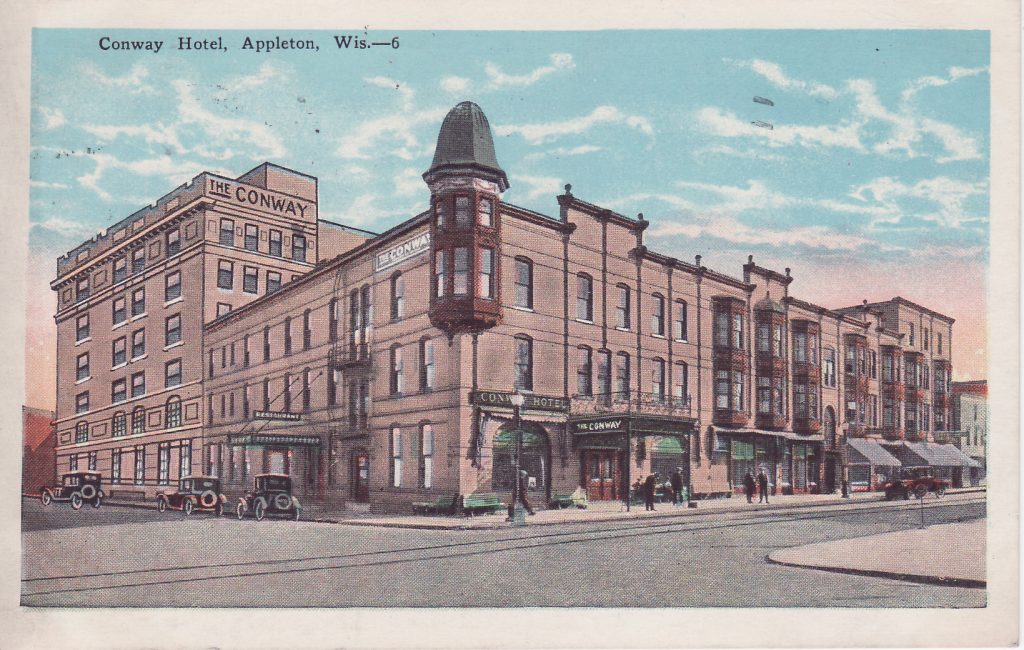
The first deliveries of the new cheese product to the Conway Hotel Tavern were packed in paper cottage cheese containers, which Hubert labeled simply: Club Cheese, Manufactured by the South Kaukauna Dairy.6
His daughter, Mabel, reported in 1947 that he had not been satisfied with this simple packaging, which “proved unsatisfactory for keeping the cheese,” she went on to say that “Dad wrote to the stoneware company at Monmouth, Ill., and asked about a stone container. They sent us a three-pound jar they had on hand. He liked it and since then has made a number of patented changes in design to make it right for Kaukauna Klub.
‘When we used up what crocks they had on hand, we could not understand why they were not able to give immediate delivery on more. It was the depression, and they were not even in operation,’ she says.
At first only the three pound size was used. A small crock was made up for samples. Now [1947] there are four sizes.”7
In 1934, the company was ready to label its new product, and the time had come to decide upon a name. After much discussion, Hubert is reported as saying: “‘Why don’t we name it after the place where it is made and call it Kaukauna Club.’ Then it was decided to change the ‘C’ of Club to ‘K’ for copyrighting reasons.”8
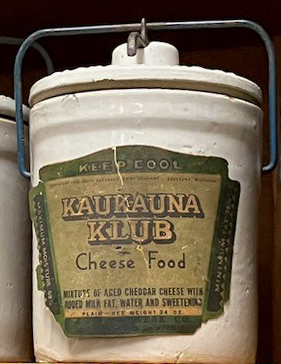
On February 24, 1934, a label for Kaukauna Klub was submitted to obtain a Wisconsin trademark. The full-color label can be viewed at the Wisconsin Historical Society website – to view, follow the link: https://www.wisconsinhistory.org/Records/Image/IM91275. This label was not used very long as a second label was designed in 1935, and if you visit Kaukauna’s website, Our Story page at: https://www.kaukaunacheese.com/our-story/, you will see yet another old label (in addition to a collection of crocks).
If there is one common denominator that we can attribute to how a Fassbender does business, it is this: They view a good business relationship as a partnership and expect the same from the people they do business with. The crock contract with the Western Stoneware Company was no different. Each Labor Day, the company hosted a weekend event, advertising for visitors to stop at the Monmouth Pottery Show Room and Gardens, where, starting in 1935, “…the Kaukauna Klub Cheese organization…will demonstrate their Cheese Products on both days. Their Cheese is fine and you should get acquainted with it.”9 The last year that Kaukauna participated in the event (or at least was advertised to have been in attendance) was 1939, when “The Kaukauna Club Cheese will be here again demonstrating their products and purchases can be made.”10
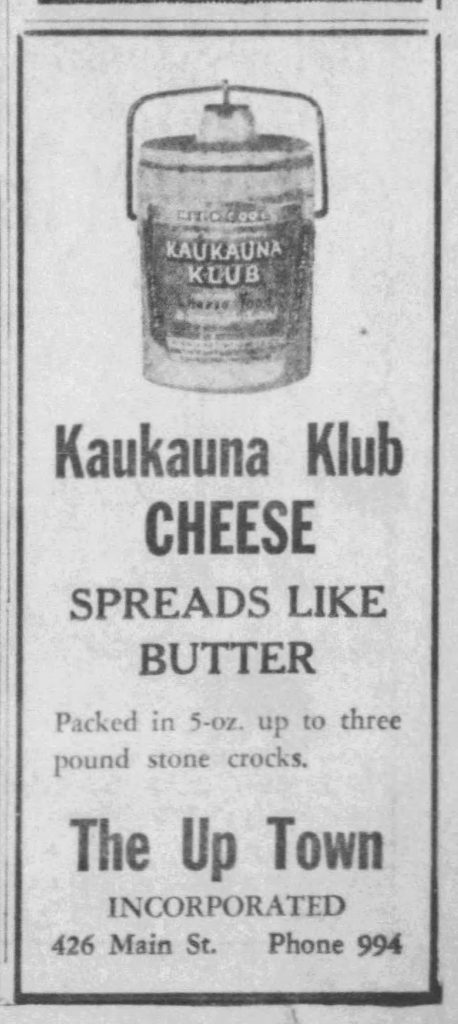
As the sturdy crocks that held the Kaukauna Klub Cheese could be reused, a program was set up so that they could be returned for credit. The Kuebler Grocery Company in Oshkosh, Wisconsin, included the return value for each size in an ad they placed in The Oshkosh Northwestern on 2 Mar 1934. The ad tells us that In 1934,11 a 3-lb jar cost 95 cents, with a return value of 15 cents. The 24-oz jar cost 65 cents, and the 13-oz jar 45 cents. Both sizes had a return value of 10 cents.
I got curious and turned to the Inflation Calculator12 to see what the price would be today. The 13-oz crock of Kaukauna Klub cheese would cost $10.23, with a crock return value of $2.27. I looked at walmart.com to see what a tub of Kaukauna would cost today and learned that to purchase two 6.5 oz tubs, equalling 13 oz. of cheese I would pay $12.47.
The Kuebler ad also reported the sale price of two pounds of peanut butter was 21 cents ($4.78), you would pay 26 cents for a pound of butter ($5.91), and a dozen eggs cost 17 cents ($3.87).
Earl Mollet, an “employe” of South Kaukauna Dairy, was invited to speak at a Kaukauna Rotary luncheon. In his talk, he shared that only 2% of the crocks were returned. He went on to say about the crocks that were returned, “It seems that people get the jars confused in their homes and return the wrong ones. When they do, the boys at the plant have a little treat.” He stated, “…once we got one back full of mince meat, another full of salted fish, and some with pickles or candy in them.”13
The fact that only 2% of the crocks were returned indicates to me that Kaukauna Klub was prized not only for what came inside the crock but also for the crock itself. Young’s Market Company ad told readers that the cheese “…comes in cunning stone jars which may be returned for credit if you wish…but you’ll want to keep yours…”14 In 1939, the R. C. Wallace Co. of Helena, Montana, Kaukauna Klub advertisement even stated that the product was “Packed in Oven-Tested Earthen Jars!”15
While Hubert continued to expand the size and shape of Kaukauna Klub, the product continued to be packaged in stone jars for many more years. In 1954, a plastic lid was introduced. “This new lid makes it easier to store in your refrigerator or to stack the jars for display purposes.”16
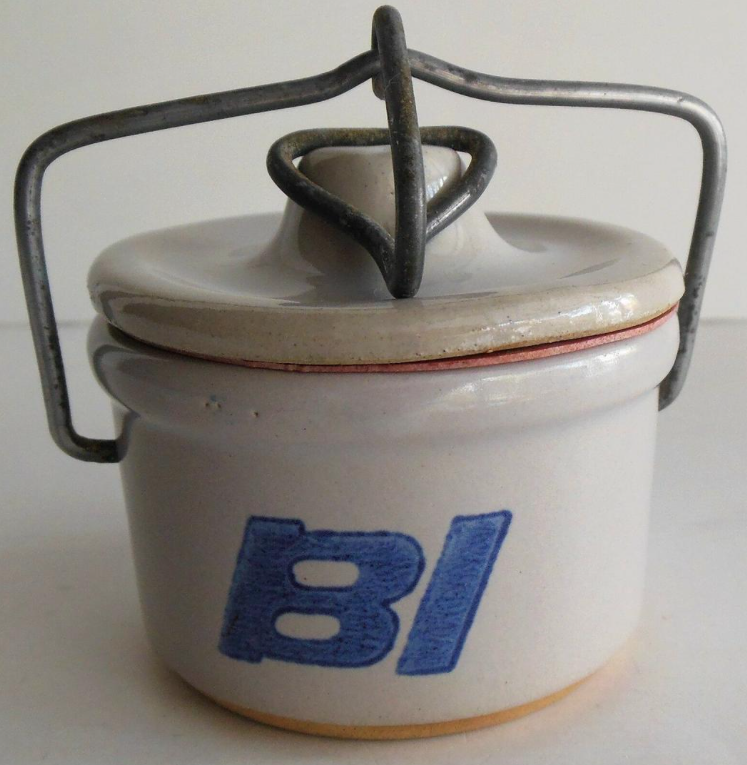
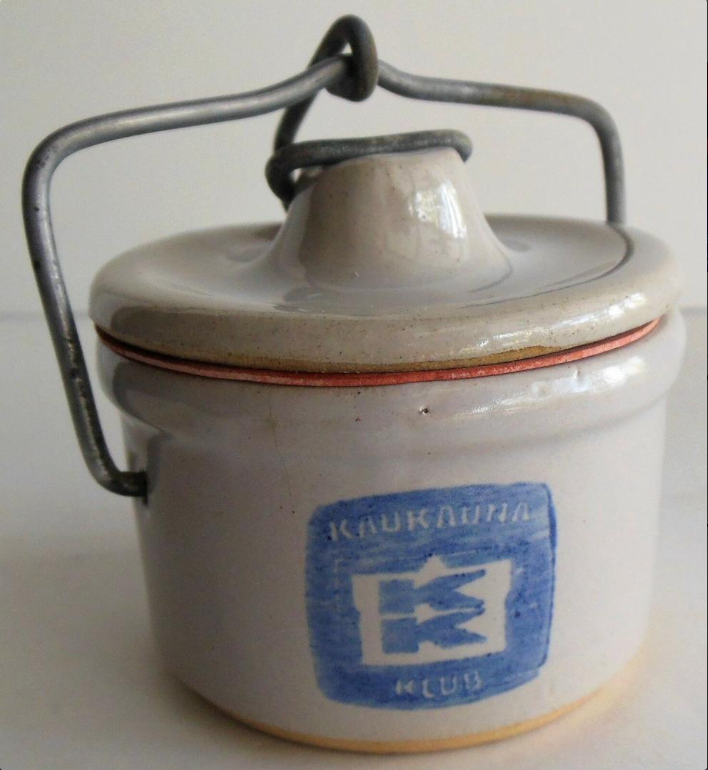
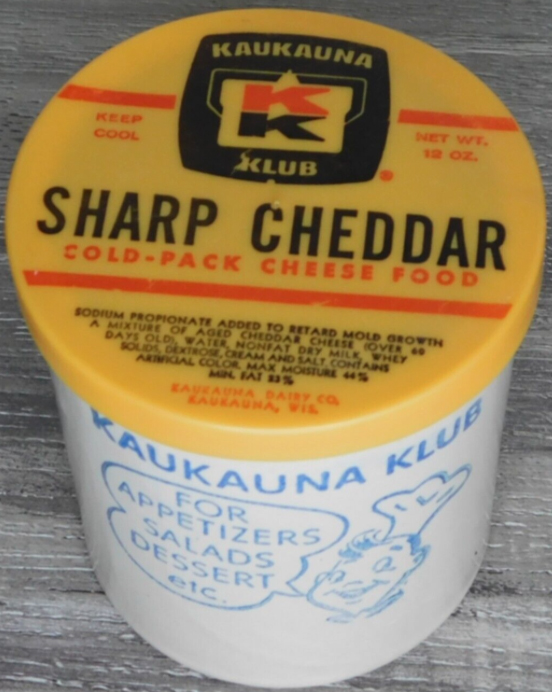
In the 1960s, the company partnered with Braniff International Airways to create a small crock of cheese to be served to the airline’s first-class passengers. While I have yet to find any written confirmation as to this partnership, examples of this small crock still exist.
By 1963, a brown crock had been added.17 In 1969, the cheese food caught the attention of a restaurant owner in Anaheim, California. The Aladdin Restaurant began serving the cheese as part of their appetizer offerings. “When each person is seated for dinner a wooden tray with an unusual cheese and crackers is brought to the table. The cheese is a good sharp soft (for easy spreading) Kaukauna Klub. It comes in an attractive brown crock–and it is a good appetizer with cocktails.”18
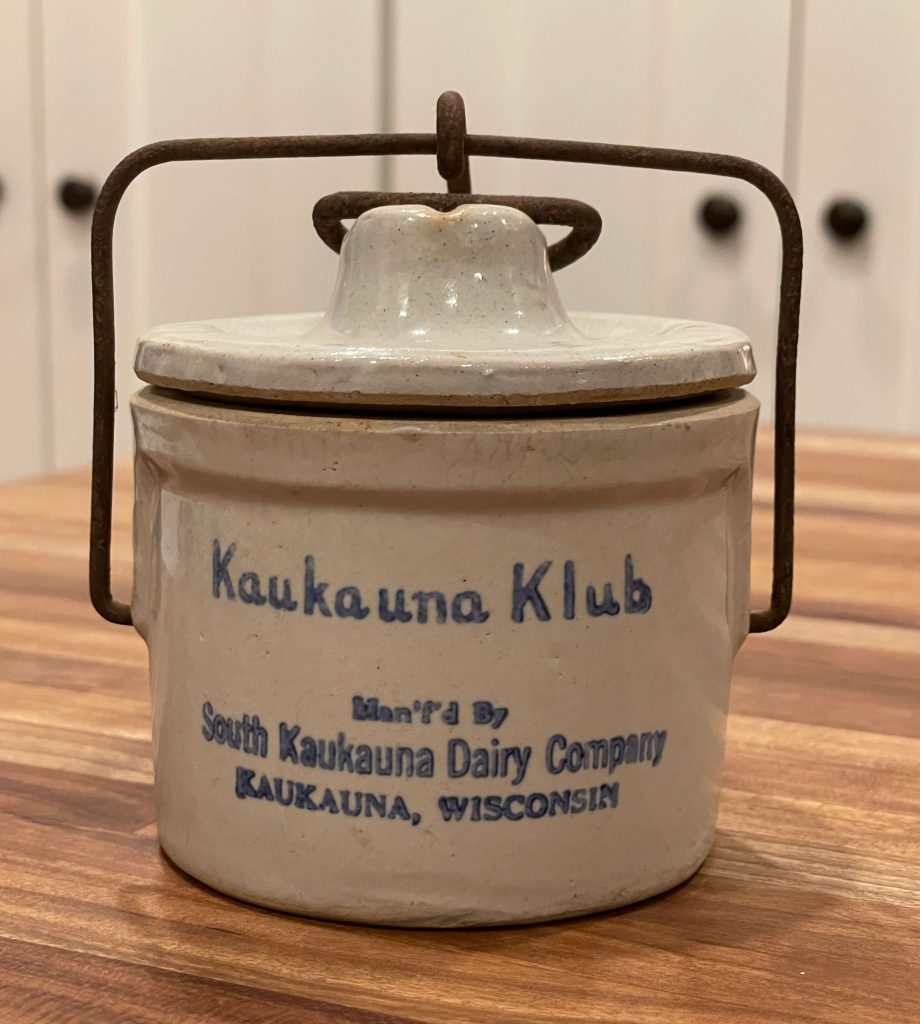
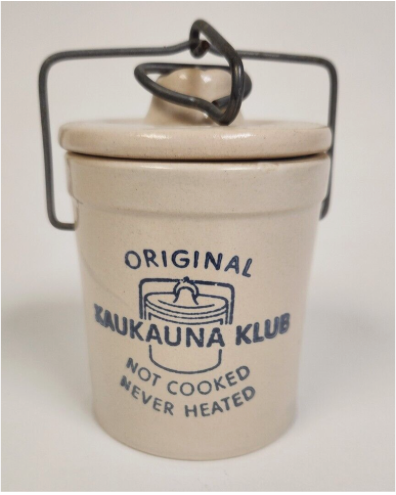
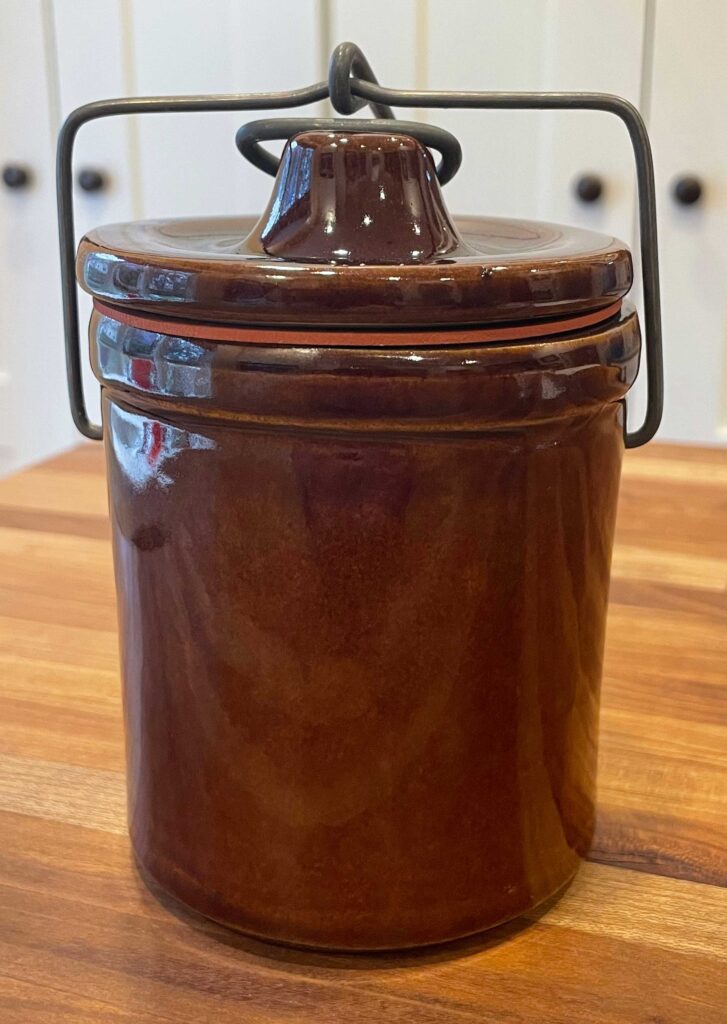
The plastic tub was introduced following the sale of the company to International Multi-Foods in 1971.19 In 1975, recognizing the continued popularity of the original crock, International Multi-foods began to offer crock refills to their mix of products.20
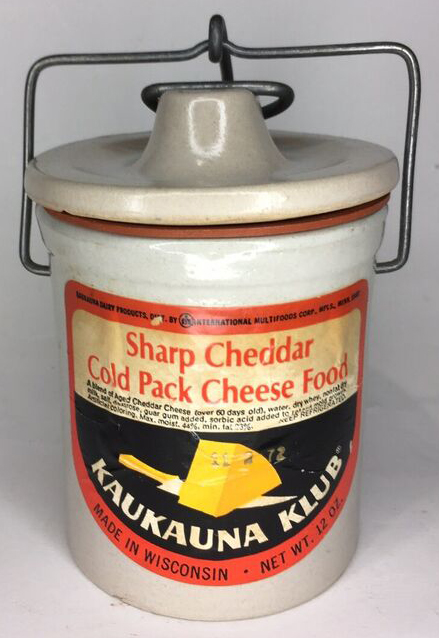
More research will need to be done to determine who manufactured these later crocks, including taking a hard look at the shape of the lid and the style of the bail. Not to mention what the bottom looks like, as this, too, is indicative of the manufacturer. SHUCKS, more parts to study.
To honor Hubert Fassbender’s achievement, in December 1947, the Kaukauna Common Council approved the appropriation of $1,301.50 for the purchase of a stone monument, a replica of the crock that is now synonymous with Kaukauna Klub. They granted Appleton Marble and Granite Works of Appleton the contract to create the monument of “polished granite with a stainless steel handle and clamp, and rough-cut granite base.”21 The Kaukauna Rotary donated the bronze plaque that reads: ‘Dedicated to the memory of Hubert Fassbender (1875-1947), the originator of the Kaukauna Klub, a dairy product which has made the city of Kaukauna known throughout the country.”22 The monument was dedicated on 8 Nov 1948 by his daughter, Mabel, along with L. C. Smith, master of ceremonies, Mayor Joseph Bayorgeon, and Kaukauna Rotary Club president, James Bamberry.
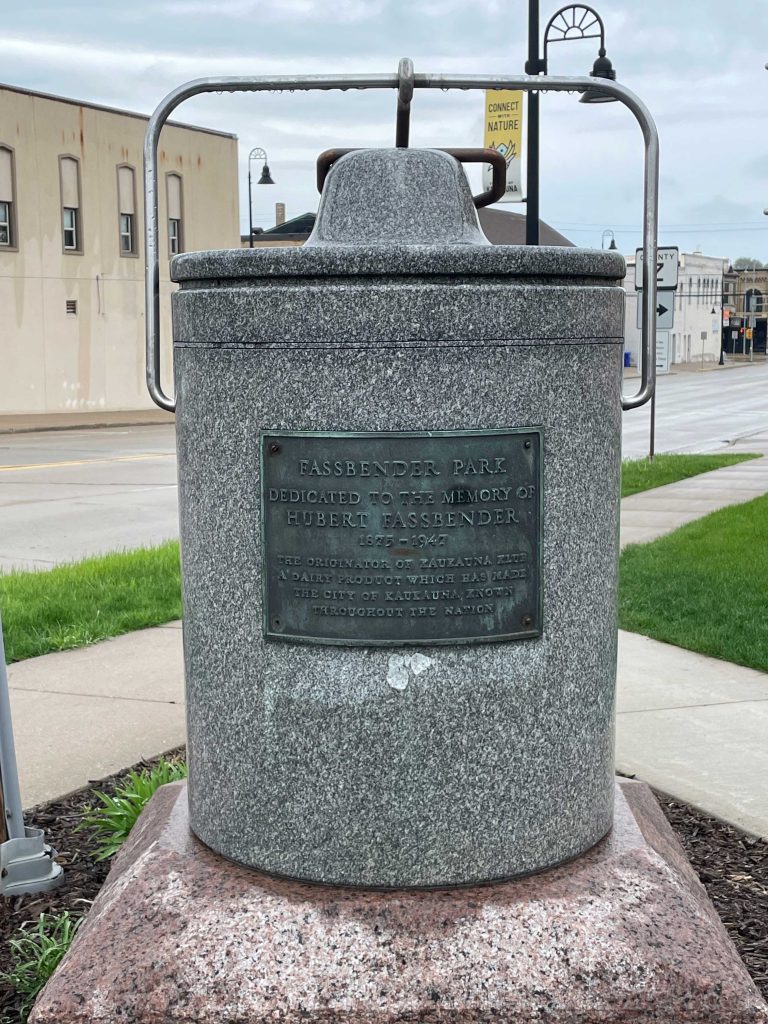
If you visit Kaukauna today, you can head to Fassbender Park, next to the Associated Bank building, which sits on the site of the original South Kaukauna Dairy plant. Here, at the triangle of Crooks Avenue, Quinney Avenue, and E 4th Street, you will find a replica of the Western Stoneware crock that made both the product and the city famous.
I would like to end with one last crock story. In 2015 I received an email sharing details of a very large Kaukauna Klub crock. According to the story, Hubert had a large replica crock made for his daughters. His daughters, Mabel and Gertrude, did not want the crock, so it was given to an employee. Later the crock, standing about waist high, made its way back to Kaukauna Klub and was used in the cheese store as a sample table. The factory cheese store is now closed, and the location of the crock is not known.
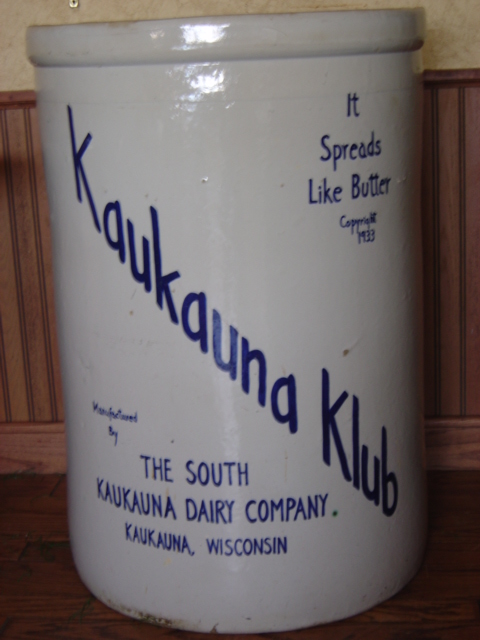
SOURCES
- “Get New Pleasure From Cheese Made By Kaukauna Firm” Appleton Post-Crescent, 21 Apr 1934, Saturday, p. 18, col. 3; digital image, Newspapers.com (www.newspapers.com : accessed 10 Sep 2018). ↩︎
- Newspaper Clipping, The Kaukauna Times, 18 Jun 1947 (guesstimate); South Kaukauna Dairy Company History; privately held by Susan Sternitzky Fassbender, 2012. “Hubert Fassbender and New Cheese Product Made Kaukauna Famous.” Bernard and Marie Fassbender Family Archives. ↩︎
- “H. Fassbender for Gettelman’s Beer,” Advertisement, Appleton Post-Crescent, 12 Jul 1933, Wednesday Evening, p. 3, col. 1; digital image, Newspapers.com (www.newspapers.com : accessed 6 Sep 2018). ↩︎
- “H. Fassbender for Knapstein’s Beer,” Advertisement, Appleton Post-Crescent, 6 Oct 1933, Friday, p. 14, col. 5; digital image, Newspapers.com (www.newspapers.com : accessed 6 Sep 2018). ↩︎
- Letter, written by Hubert Fassbender on South Kaukauna Dairy Company letterhead, ca 1935; South Kaukauna Dairy Company History; privately held by Susan C. Sternitzky Fassbender, 2012. ↩︎
- Newspaper Clipping, The Kaukauna Times, 18 Jun 1947 (guesstimate); South Kaukauna Dairy Company History; privately held by Susan C. Sternitzky Fassbender, 2012. “Hubert Fassbender and New Cheese Product Made Kaukauna Famous.” Bernard and Marie Fassbender Family Archives. ↩︎
- Ibid. ↩︎
- Ibid. ↩︎
- “Visit the Monmouth Pottery Show Room and Gardens” Advertisement, The Rock Island Argus, 29 Aug 1935, Thursday, p. 5, col. 6; digital images, Newspapers.com (www.newspapers.com : accessed 10 Jan 2024). ↩︎
- “Monmouth Pottery” Advertisement, The Rock Island Argus, 1 Sep 1939, Friday, p. 22, col. 5; digital images, Newspapers.com (www.newspapers.com : accessed 10 Jan 2024). ↩︎
- “Kuebler Grocery Co. Look! At This,” Advertisement, The Oshkosh Northwestern, 2 Nov 1934, Friday, p. 16, col. 5; digital image, Newspapers.com (www.newspapers.com : accessed 11 Jan 2024). ↩︎
- https://www.usinflationcalculator.com/ ↩︎
- “Cheese Jars Sometimes Come Back With Pickles,” Appleton Post-Crescent, 5 Aug 1937, Thursday Evening, p. 18, col. 2; digital images, Newspapers.com (www.newspapers.com : accessed 4 Feb 2018). ↩︎
- “Young’s Market Company,” Advertisement, Los Angeles Times, 8 Mar 1938, Tuesday Morning, Part II, p. 5, col. 1; digital images, Newspapers.com (www.newspapers.com : accessed 11 Jan 2024). ↩︎
- “Kaukauna Klub,” Advertisement, The Helena Daily Independent, 24 Jun 1939, Saturday, p. 3, col. 7; digital image, Newspapers.com (www.newspapers.com : accessed 11 Jan 2024). ↩︎
- “Has New Plastic Lid. Kaukauna Klub Begins New Advertising Campaign” The Appleton Post-Crescent, 16 Oct 1954, Saturday, p. 9, col. 1; digital image, Newspapers.com (www.newspapers.com : accessed 28 Jan 2024). ↩︎
- “Beechners,” Advertisement, The Lincoln Star, 13 Dec 1963, Friday, p. 10, col. 3; digital image, Newspapers.com (www.newspapers.com : accessed 26 Jan 2024). ↩︎
- “Food and Fun,” The Santa Ana Register, 19 Sep 1969, Friday, p. D, col. 6: digital images, Newspapers.com (www.newspapers.com : accessed 26 Jan 2024); Marilyn Nelson. ↩︎
- “Firm Buys Kaukauna Dairy Co.,” The Post-Crescent, 2 Mar 1971, Tuesday, p. B12, col. 2; digital image, Newspapers.com (www.newspapers.com : accessed 28 Jan 2024). ↩︎
- “Kaukauna Klub” Advertisement, The Chicago Tribune, 20 Nov 1975, Thursday, Section 6, Food Guide, p. 4, col. 4; digital image, Newspapers.com (www.newspapers.com : accessed 26 Jan 2024). ↩︎
- “Memorial to Be Erected For Fassbender,” Appleton Post-Crescent, 17 Dec 1947, Wednesday, p. 10, col. 2; digital images, Newspapers.com (www.newspapers.com : accessed 11 Sep 2018). ↩︎
- Newspaper Clipping, The Kaukauna Times, 19 Dec 1947; South Kaukauna Dairy Company History; privately held by Susan C. Sternitzky Fassbender, 2012. “$1,301.50 Appropriated for Hubert Fassbender Memorial.” Bernard and Marie Fassbender Family Archives. ↩︎

I actually have a small crock. It was my Mother’s. She worked in Butte, Montana. Worked at Gamers,a bakery ‘restaurant. Late 30’s to mid 40’s. Never realized it’s importance, thank you for revealing the mystery. I use mine for espresso.
I love that you are using the crock! Never thought to store espresso in it, but this is exactly what Hubert wnated people to do with the empty crocks – use them. Thank you so much for sharing.
Susan
What a wonderful article!! The research benefit is of immeasurable benefit to our Western Stoneware history. It makes me want to know more details about the Kaukauna Klub company and especially “The rest of the story” which means the me….what happened to the over-sized crocks! I cannot help but believe that with more people reading this history and more people knowing about the existence of the two oversized Kaukauna Klub crocks, one or both of these crocks could surface. Wouldn’t that be something!!! Thank you so much for all this information. Please know that the Stoneware Museum in Monmouth, IL appreciates this information. We have to keep history alive.
Thank you LaDonna! I am always researching.
Wonderful story and the connection with Western Stoneware Pottery. So glad to have found you!!
Thank you so much! I do love a good research project.
I am from Kaukauna. We always had a crock in thr fridge. I have several crocks I have. Ollexted over the years. I even found one in Ohio when we lived there. Love your stories and your research is amazing and inspiring. I know I have the Fassbender name in my tree.
Thank you so much for your kind words! I am glad you liked this story. If you like crocks, you should definitely check out the Stoneware Museum of Monmouth’s website and Facebook page. I would love to know where you have Fassbender in your tree.